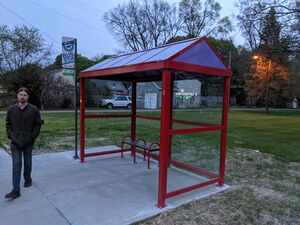Bus stops: Difference between revisions
From
No edit summary |
No edit summary |
||
| (7 intermediate revisions by the same user not shown) | |||
| Line 1: | Line 1: | ||
{{Projects infobox | {{Projects infobox | ||
|image | |image = Bus stop.jpg | ||
| | |designers = | ||
|date | |date = | ||
|tools | |vitamins = | ||
|parts | |materials = | ||
|techniques | |transformations = | ||
| | |lifecycles = | ||
|git | |tools = | ||
|parts = | |||
|techniques = | |||
|files = | |||
|git = | |||
|suppliers = | |||
}} | }} | ||
[[Category:Projects]] | [[Category:Projects]] | ||
[[Category:Shelters]] | [[Category:Shelters]] | ||
=Introduction= | |||
A bus stop is a designated place where buses stop for passengers to get on and off the bus. The construction of bus stops tends to reflect the level of usage, where stops at busy locations may have shelters, seating, and possibly electronic passenger information systems; less busy stops may use a simple pole and flag to mark the location. Bus stops are, in some locations, clustered together into transport hubs allowing interchange between routes from nearby stops and with other public transport modes to maximise convenience. | |||
=Challenges= | |||
=Approaches= | |||
=References= | |||
* [https://en.wikipedia.org/wiki/Bus_stop Wikipedia: Bus stop] | |||
* [https://kibo.gr/en/ Kibo portable shelters] | |||
Latest revision as of 06:03, 23 September 2021
Introduction
A bus stop is a designated place where buses stop for passengers to get on and off the bus. The construction of bus stops tends to reflect the level of usage, where stops at busy locations may have shelters, seating, and possibly electronic passenger information systems; less busy stops may use a simple pole and flag to mark the location. Bus stops are, in some locations, clustered together into transport hubs allowing interchange between routes from nearby stops and with other public transport modes to maximise convenience.
